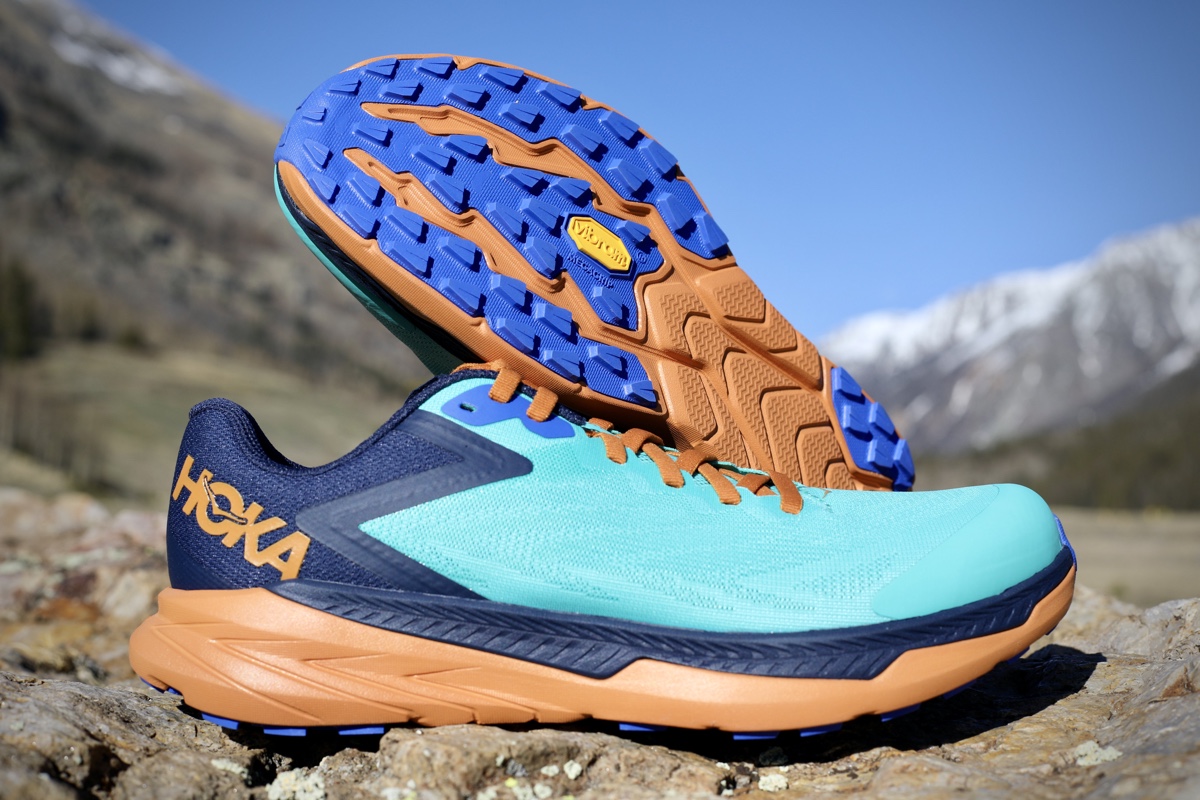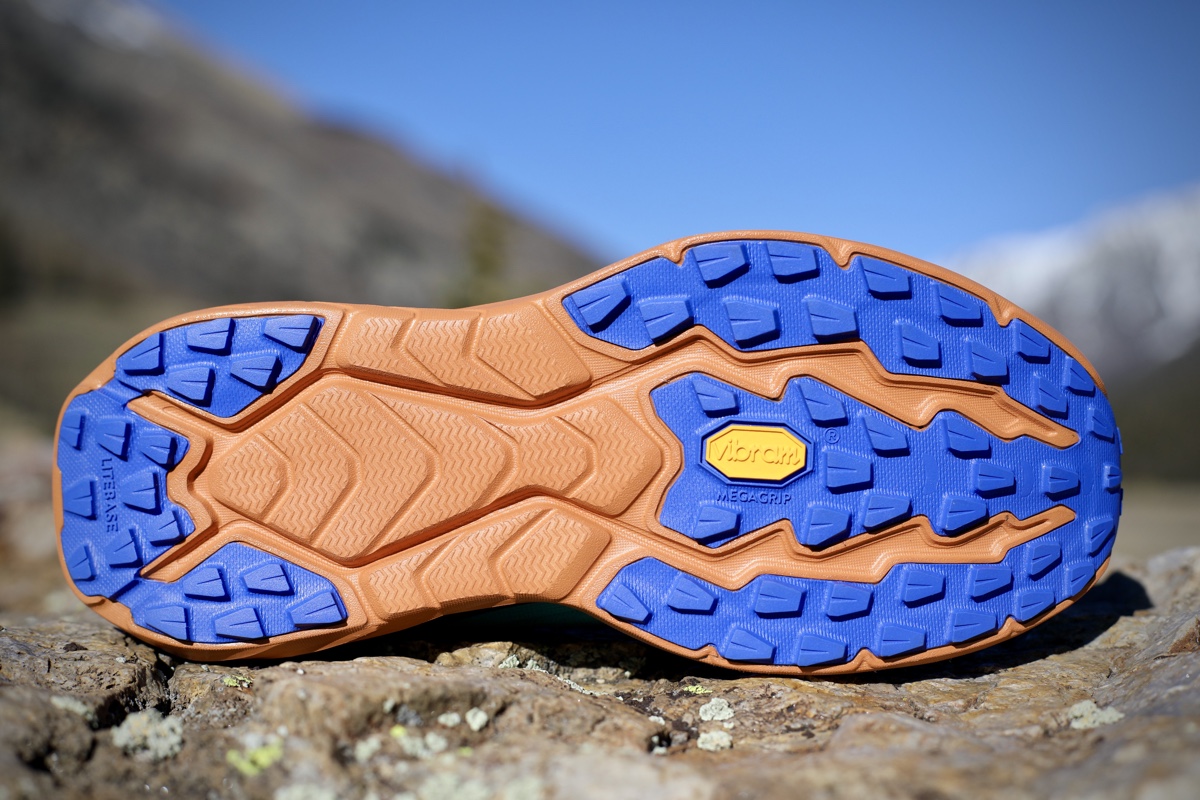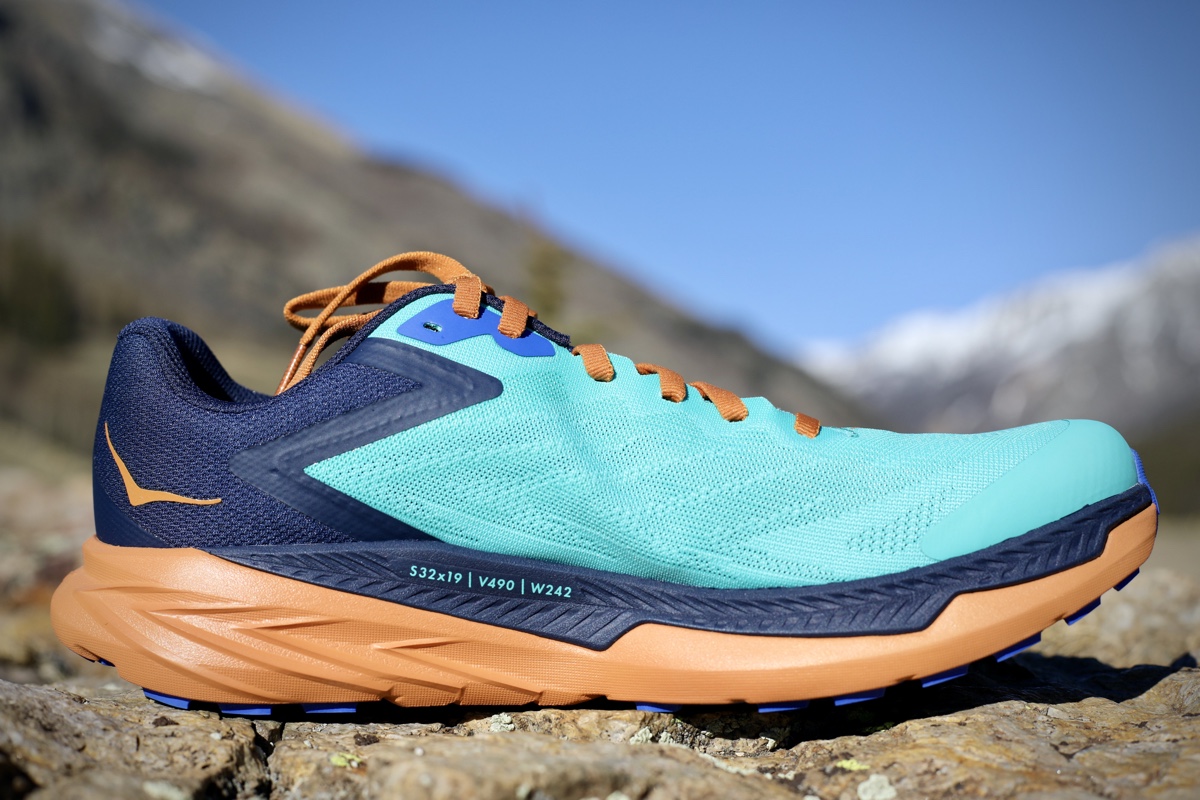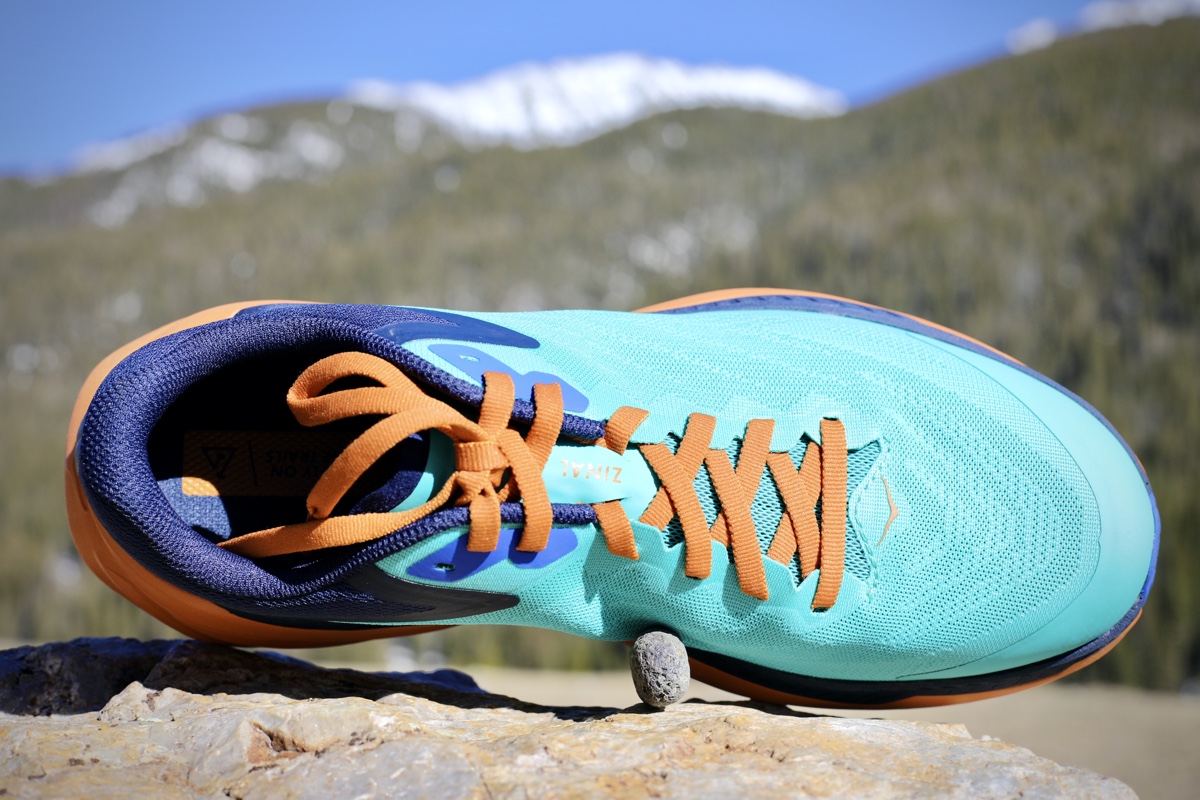For the latest on the Zinal, you can read our Hoka Zinal 2 review.
Our Favorite Trail Running Shoes
Check out our Best Trail Running Shoes article to learn about our current favorite trail running shoes!
Hoka Zinal Review
The brand-new Hoka Zinal ($160) is positioned as a shorter-distance trail running and racing shoe, but our reviewer found it developed enough that he’d consider racing 100 miles in it, too. Let’s look more closely at this shoe’s simple upper, dual-density midsole that includes Hoka’s PROFLY foam, Vibram Megagrip Litebase outsole, and much more.
Overall, we named the Hoka Zinal as the best trail racing shoe for up to 50k in our best trail racing shoes buyer’s guide. For our best generalist trail shoe picks, check our best trail running shoes buyer’s guide.
Shop the Men's Hoka ZinalShop the Women's Hoka Zinal
Hoka Zinal Review Transcript
Hey, and welcome to Trail Trials, the video-review section of iRunFar. My name is Travis Liles, and in this video, we’re looking at the new trail shoe from Hoka, the Hoka Zinal.
Let’s dive into the specs. This is a 4-millimeter heel-to-toe drop. This weighs in at slightly under 8.5 ounces in a men’s size 9. It is positioned as a quick shoe for going shorter distances with a Vibram Megagrip Litebase outsole and a dual-density midsole. Let’s get up close and personal and see what this shoe is all about.
Hoka Zinal Outsole
Let’s start off by talking about the Hoka Zinal outsole. You have a very lightweight, stripped-down outsole. And you’ll hear me say lightweight and stripped down throughout this entire review. This outsole maybe covers half of the shoe, and you can see it all from this blue section here, all that is the Litebase option of Vibram Megagrip. Litebase is a lightweight version of Megagrip, while maintaining the same performance characteristics. In terms of feel it’s the same, like semi-sticky, rubbery, really good grip on a lot of varied surfaces. Whether you’re talking about like slick wood bridges, or you’re talking about a rock or scree fields or whatever, like it’s just a good, strong, all-around tread compound.
The difference is that Litebase cuts about 30% of the weight off of standard Vibram Megagrip. What would that be? If you were to tear off this tread and replace it with standard Vibram, it would be about 30% heavier. What would that really do? Probably with this tread it’s sensitive, it’s pretty small and not a whole lot of it. It maybe would add another half ounce to the shoe, but it’s enough of a difference that this shoe is trying to stay light and fast. They went with the Litebase compound on here. According to Vibram, the performance between the two is the same. I don’t know about life of the lugs, if it’s shorter on Litebase versus standard, but in terms of what it feels like underfoot, how I feel when I’m stepping on things, it feels pretty much the same.
From a lug pattern, you can see that they’re fairly shallow. It’s not a very deep lug on this shoe. Definitely that low profile type of lug that’s meant for do-it-all type of stuff. And Hoka is really positioning this shoe as lightweight, fast, shorter distance. But I found it did well in a lot of different areas, not just easy, groomed type of trail. There’s enough here, but it is not an overly protective shoe.
And you can tell that just by looking at all of this midsole foam. You take this orange foam, you roll all the way through. There are a lot of exposed areas. And in fact, if you look right here, that’s a thorn that got stuck in the shoe. Let’s grab this little multi-tool here and look. You know, that’s a fairly long stick that was in the shoe. I didn’t ever feel that poke through, but that’s sort of an example of protection that you’re not getting on the bottom of this shoe, right? If this would have been rubber all the way across, I probably wouldn’t have had that issue, but that gives you an example of what you’re working with here. I didn’t feel it poke through because you still have all this midsole plus your sock liner before it hits you. But that is an example of what you’re not getting with this shoe. There’s no rock plate in here. It’s just lightly covered with tread. Exposed foam and that’s done for saving weight.
Hoka Zinal Midsole
Moving on to the midsole of the Hoka Zinal, and the midsole is pretty interesting in that it’s slightly different than a majority of Hoka shoes, which tend to be, specifically in the trail range, a little more single-density foam. You have two levels of foam here. One is the PROFLY foam, which is the same that was on the Torrent. It’s the same in their performance shoes, like the Carbon X. And then on top of it, there’s a rubberized EVA foam. And that’s to give it a little more rebound or a little more firm feel. I think it performs really well, but from a mechanical standpoint, there’s nothing on this shoe that’s correcting your footstrike or doing pronation control. It’s a neutral shoe that uses two types of foam to create a more fast-like feel.
Looking at the specs here, like we saw on the previous Hoka Torrent 2 review, you’re going to see a couple of numbers here and those numbers represent weight of the shoe, how much volume is in the shoe, and the spring of the shoe. Weight: 242 grams, about 8.5 ounces, men’s size nine. Here we have in cubic centimeters, the volume of the midsole. This comes in at 490 cubic centimeters for a reference point. The Torrent is 395 and something like the Challenger comes in at 641. The Zinal is quite a bit less than the Challenger or the Speedgoat, but more cushion and more volume available than the Torrent.
Lastly is that spring number. This shoe has a rocker. It is not a super pronounced rocker, but there’s enough there. And if we look at it from the side, you get a little view of that ramp from heel to toe and see how it bows like this. And that’s all they’re meant to go fast meant to be efficient, two types of foam here, plus this midsole feel, it’s really lightweight and it really feels like you can move in this shoe fast, regardless of the terrain, regardless of road, regardless of kind of what you’re doing.
Hoka Zinal Upper
When you move up to the Hoka Zinal upper, again, just like everything else on the bottom part of this shoe, it’s really meant to be simple and it’s meant to save weight. You can tell just by quickly looking, there’s not a lot going on with this. I mean, in terms of trail running shoes, this is about as simple as it gets from an upper standpoint. Mesh all the way through here. Very few overlays. There’s not anything that’s like straps on the inside of the shoe that connects the laces to the midsole for a wrapper type of fit. You don’t have TPU overlays with the exception of a couple here by the laces, which we’ll call out in a second, around the shoe for abrasion resistance or for added structure, the shoe’s about lightweight, and that’s exactly what’s going on, on this upper.
That said, it locks my foot in fairly well, and there’s a couple of reasons for that. One is there’s just enough mesh here. And I think the way that they structure the upper, at least for my foot shape, locks it in and provides enough wrapper there that my foot doesn’t feel like it’s swimming around inside of the shoe. The secondary portion here is that it’s a flared outsole in general. When you look at the bottom part of this shoe, it’s a wide heel. The heel is out to here, and if we roll that in, you can see that there’s a fairly large ramp from the farthest-out part of the heel to the actual shoe itself. That’s a fairly good distance and you have that on both sides, and then when you look down from this angle here, you’ll get that same type of view. As we move our way up, here’s where the upper stops and then the outsole juts out another half inch or so on each side. There’s sort of this bucket that you sit down inside of this shoe. When you combine that, that’s the platform that’s creating the stability for this shoe.
And then the upper is doing just enough to keep your foot locked in, again, and to keep out some dirt and debris. But for the most part, really lightweight in terms of what this shoe is doing. Very minimal on abrasion resistance with the exception of right up here at the toe. You do have this overlay that is bonded to the fabric right at the toe that is going to add some abrasion resistance. And then at the very, very apex, the outsole wraps up and around and adds a fairly hard spot right at the very tip to add some protection against kicking and those types of things.
Continuing onto the tongue, it is a partially gusseted tongue. There is a little bit of fabric, probably from about this second, third lace down all the way to the cross lace down at the bottom, where this has gussets to try to keep out dirt and those types of things, and also create a sock-like feel, though there aren’t any stitching or anything like that, that you really have to worry about rubbing against. But for the most part, again, a surprising amount of support in the upper given how minimal it is. And then that same theme continues here with the tongue. The tongue is super thin. It is really just a kind of rubbery overlay bonded to some mesh fabric with a really tiny slice of padding on the inside, to give just enough pressure relief from when you’re locking those laces down.
Then from the heel-cup standpoint, sticking in that theme of minimal, very light structure. Semi-structured heel cup. I can push that down with one finger. It’s a little bit of effort, but it’s not much, it is a very minimal heel cup, especially in comparison to a lot of other shoes out there. You can feel it, there’s a little bit of that, something in here, a piece of plastic, but it is very flexible compared to a lot of other heel cups that would collapse down really hard, or really present a bunch of structure. It’s fairly lightweight, but again, there’s just enough here to give some structure and lock your heel in and to keep this shoe attached to your foot when you’re trying to run and go fast.
Hoka Zinal Overall Impressions
In closing, the Hoka Zinal is a pretty interesting shoe. It is positioned to be for shorter-distance races, really meant about going fast. And I think it accomplishes that really well. Everything I’ve thrown at this shoe, it’s handled admirably. That’s some very aggressive scree and rocks and roots and slick stuff and water crossings and wet all the way to fire roads, road running, forest roads, really buffed-out trail. The shoe transitions well, it feels good. It’s got a stable, wide platform on it that’s flared out that feels secure, but it’s also only 8.5 ounces and it’s a really feathery, lightweight, meshy upper that breathes well. And then you’ve got a good midsole that has got dual density, that rides well, it’s got that rocker feel. There’s just a lot here to like, and I think where you’re going to have your biggest problem with his shoe is not asking, can you run 100 miles in it? Because I absolutely think this shoe is going to work for that.
What I don’t know is, can I use this as my training shoe and then get to the start line with this shoe? And I’d argue that you’re probably going to have a shoe that is not going to have as long of a life as some of the other types of trail shoes, even ones by Hoka. There are no layers and material and sort of scuff-resistant areas on the upper. You’ve got a whole lot of midsole that’s exposed and doesn’t have tread on it at all. You gain all this really great lightweight, but that comes with a sacrifice and that’s the sacrifice of a less structured upper. A less structured bottom package and outsole on this because there just isn’t a lot of protection anywhere on this shoe, from that abrasion and stepping on sharp things. But I think you could do it because I have ran some pretty nasty terrain in this shoe. I just don’t think this is a shoe that you could do really long-distance races and use as your everyday trainer. I think it’s a specialized shoe. I think what it does, it does well. I think for fast mountain races, there’s enough here to take care of it. I think for a long distance race, 100 miles, I think there’s enough shoe here.
Again, I’m sort of round peg in a square-hole type of situation here by saying, is this shoe meant for really long distance? Hoka themselves is not positioning this as a long distance shoe. I think you can do it. And I think it’d be a pretty awesome race shoe given the right conditions and given the expectations that, that might be all you get out of this one, depending on again, how rugged things are and how tough you are on your shoes.
Shop the Men's Hoka ZinalShop the Women's Hoka Zinal
Call for Comments
Questions, comments, are you excited about the Zinal? Leave those below this video. Thanks for watching, we’ll catch you next time.
[Editor’s Note: If you’re affiliated (i.e., an employee, ambassador, etc.) with a brand, please share your relation in each of your comments on this article. Thanks!]
Our Favorite Trail Running Shoes
Check out our Best Trail Running Shoes article to learn about our current favorite trail running shoes!
A top view of the Hoka Zinal.





